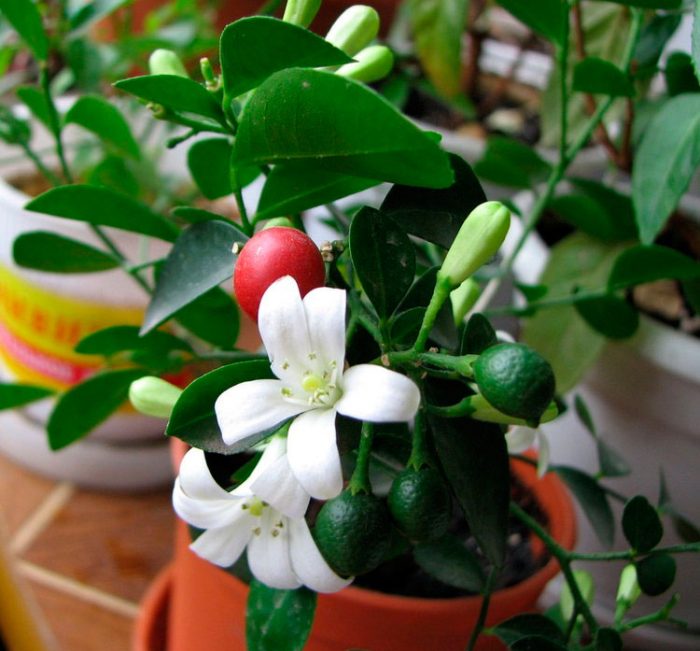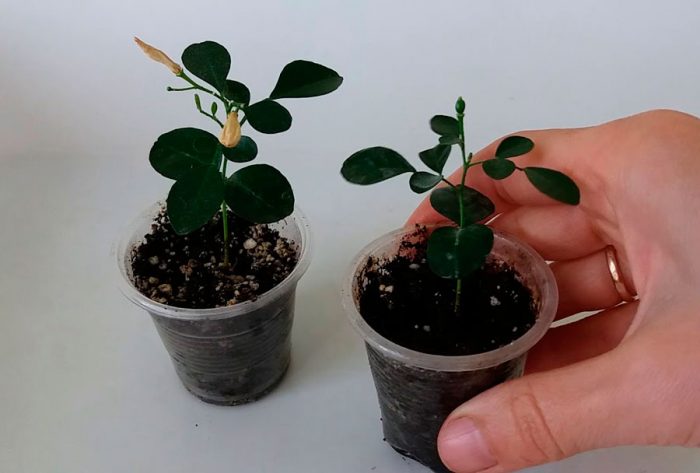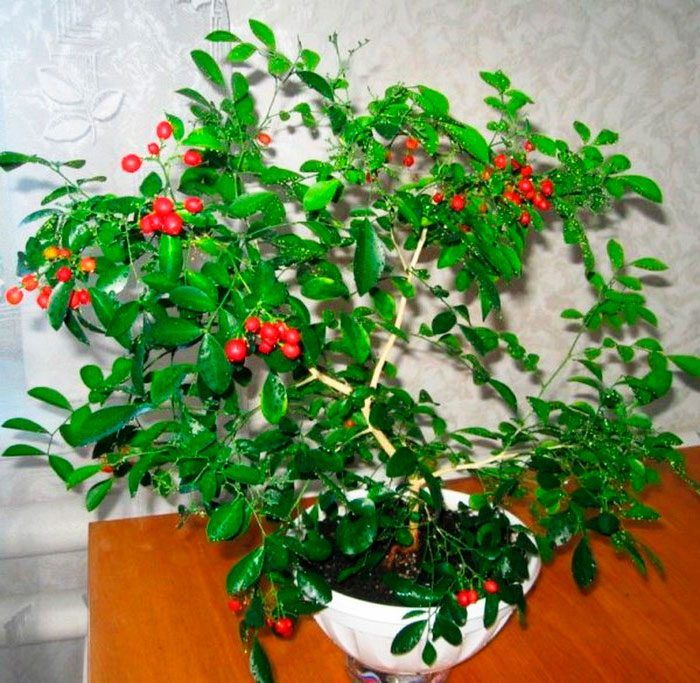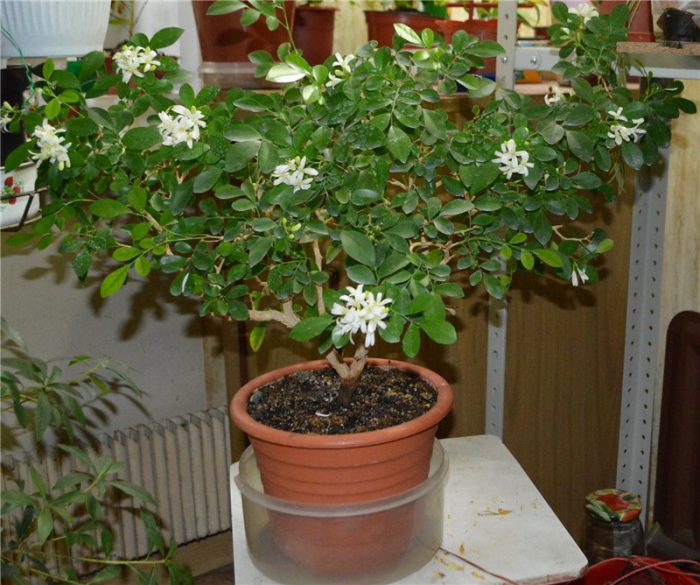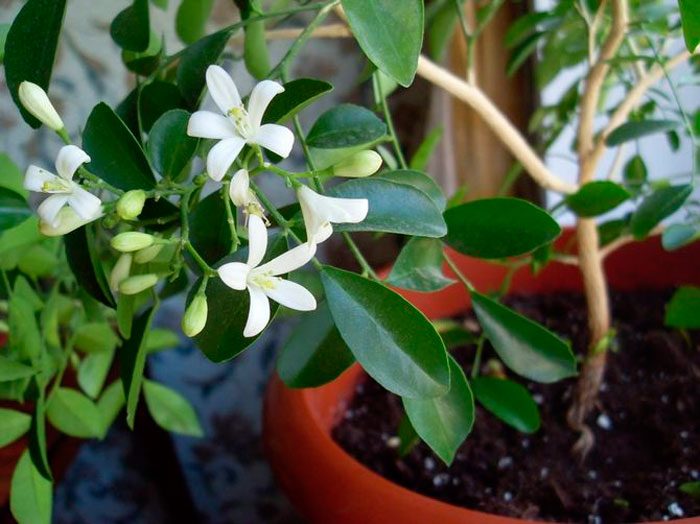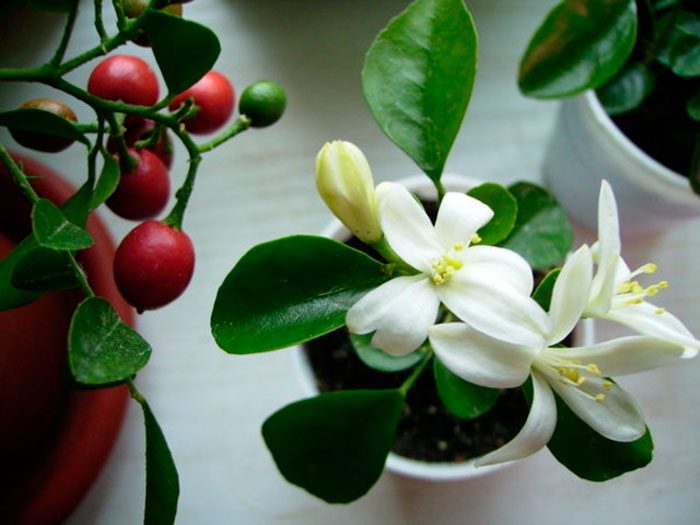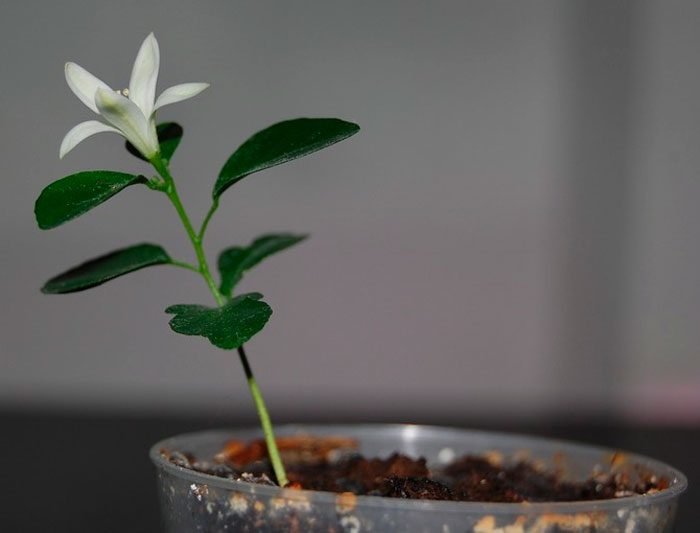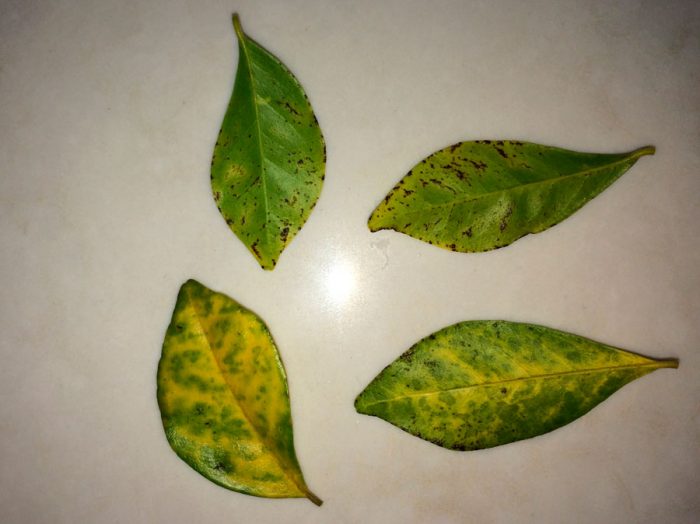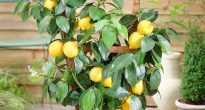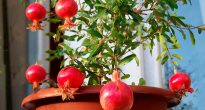Evergreen trees and shrubs Muraya, or Murraya (Murraya) are members of the Rutaceae family. Their homeland is India, Indochina, as well as the islands of Java and Sumatra, while this culture prefers to grow in tropical forests. This plant was named after the Swedish botanist Johan Andreas Murray, who was a student of Carl Linnaeus. This genus unites 8 species, but only one is cultivated at home, namely, muraya exotic, or paniculate.
Content
Murayi features
In the wild, Muraya paniculata, also called Murraya paniculata, is an evergreen shrub or tree that reaches 7 meters in height, while the trunk is approximately 13 centimeters across. This species also has undersized forms, the height of which does not exceed 200 cm. Glossy smooth odd-pinnate leaf plates are complex, they consist of 3-9 leaves. The foliage has a pleasant smell. On the surface of young foliage there is pubescence, while in mature plates it is smooth. Fragrant flowers, reaching 20 mm in diameter, can be painted cream or white, they have 5 petals, which are bent back. The fruit is a small red berry that will fully ripen about four months after emergence. At the same time, blossoming flowers, buds, and also berries may be present on the bush. Under natural conditions, this species can be found in Southeast and South Asia, the islands of Java and Sumatra, Northern Australia, Taiwan, India, Malacca, the Philippines, southern China and the southern part of the United States.
Growing muraya from seeds
It is very easy to grow Muraya from seeds indoors. It should be known that the seed remains viable for a relatively long time. Before sowing, the seeds should be kept in lukewarm water for 2 hours, then they should be evenly distributed over the surface of a moistened soil mixture, which includes sand and peat (1: 1). You can also grow seedlings in peat tablets or a soil mixture consisting of sand and leafy earth. It is not necessary to deepen the seeds into the substrate; they should be covered with a thin layer (0.5–1 cm) of soil mixture on top.The containers on top must be covered with glass or film, then they are transferred to a well-lit place where there are no direct rays of the sun, while the air temperature should be from 22 to 28 degrees. The first seedlings should appear 30–40 days after sowing, and after they have formed 3 true leaf plates, the plants should be cut into individual pots. Muraya, grown indoors, is distinguished by its undemanding nature.
Muraya care at home
Illumination
The room in which the flower is located must be systematically ventilated. Lighting should be diffused, but from 2 to 3 hours a day the bush can be in direct sunlight. In winter, it is necessary to ensure that the muraya has enough light. Experts advise placing a flower near a window located in the east or west of the room.
Temperature
In spring, summer and autumn, this plant needs warmth (from 24 to 28 degrees), and in winter the temperature in the room should be reduced to 17–20 degrees, because muraya has a mild dormant period.
Pruning
You do not need to trim or pinch the bush, since the plant is able to form its crown on its own. However, in rare cases, it may be necessary to shorten an overly long shoot. In order for the bush to have a beautiful shape, it must be systematically rotated along with the container around its axis.
How to water
In spring and summer, the muraya will need to provide abundant, but not frequent watering. In this case, it is necessary to water the bush only after the clod of earth dries out by 1/3 part. Water is used without chlorine and soft (it is mixed with a small amount of citric acid). In autumn and winter, watering should be reduced, but the rules remain unchanged, namely, the bush should be watered only after the earthen lump dries out by 1/3.
Air humidity
The air humidity in a city apartment is quite suitable for this flower, so it does not need to be humidified every day from a spray bottle. But you still need to spray the plants from time to time, especially on hot days.
Fertilizer
In spring and summer, Muraya needs systematic feeding: once every 15–20 days. In spring, the flower needs potassium and nitrogen, which contributes to more active growth of green mass. It is recommended that organics and mineral fertilizers are used alternately for fertilizing, while trying not to overfeed the flower. In autumn and winter, it is impossible to apply fertilizers to the soil mixture.
Murayi transplant
Young specimens are transplanted every year. Adult plants are transplanted once every 2 or 3 years, but every year in spring, experts advise replacing the top layer of soil mixture in pots. The pot should be chosen so that it is not too small or very large. The soil mixture needs loose and nutrient-dense soil. For example, to create it, you can combine sod and leafy soil, humus and sand in a ratio of 2: 2: 1: 2. Muraya can also be transplanted into ready-made citrus potting soil. Do not forget to make a good thick drainage layer on the bottom of the container before planting. The transplant is carried out using the transshipment method, while trying to prevent the earthen lump from collapsing.
Bloom
During flowering, a large number of pale cream or white fragrant flowers are revealed on the bush, reaching 20 mm in diameter. Blooming muraya is very effective and can become the main decoration of any room, especially when you consider that the flowering period is about 6 months (in some cases it lasts longer).
Lack of flowering
Some growers complain that their murayi bush does not want to bloom. This can be due to various reasons.So, if a Dutch muraya is grown, then you need to remember that from the moment of purchase to the first flowering it can take from 3 to 4 years. Also, the bush may not bloom because it is grown in an overly tight container, as a rule, after transplanting into a larger pot, the bush soon begins to bloom.
Reproduction of muraya
Muraya can be propagated by seeds. How to do this is described in great detail above. Also, this plant can be propagated by cuttings, however, it should be noted that this method is unreliable. Semi-lignified cuttings are cut from yearling shoots. For rooting, cuttings should be planted in wet sand, perlite, peat, or they can be dipped in a glass of water. Cuttings need warmth (from 26 to 30 degrees), on top they must be covered with a transparent polyethylene cap or a glass jar. It will be very good if the cuttings are provided with bottom heating.
Muraya can be propagated by cuttings in September – November. Rooted cuttings need to be transplanted into individual pots filled with fertile loose soil mixture, while a good drainage layer must be made at the bottom.
Muraya diseases and pests
If the muraye does not have enough light, as well as with excessively low humidity or with improper watering, problems may begin with it. For example, a fungal disease may develop on a bush, or spider mites or scale insects may settle on it, which feed on sucking cell sap from various parts of the plant. To destroy pests, muraya must be treated twice or three times with a solution of acaricide (Karbofos or Actellik), while between sessions it is necessary to maintain an interval of 7 days. If the bush is affected by a fungal disease, then it must be sprayed with a fungicide solution (Fitosporin-M, Fundazol, Oxyhom or another preparation of a similar action). However, in order to cure a plant, it is very important to start taking proper care of it, as well as to create optimal conditions for its growth and development.
Types and varieties of murayi
It has already been said above that in indoor conditions, flower growers cultivate only varieties of muraya paniculata, for example:
- Min-a-min... This variety is the compact form of the Smart Choice garden variety. The height of such a bushy plant is about 100 cm, it is characterized by rapid growth. In regions with a mild warm climate, this variety can be grown in the garden, creating magnificent hedges.
- Minima... The height of such a miniature plant is from 0.4 to 0.6 m, it is distinguished by its slow growth, and its flowering begins already in the first year of life. This variety is excellent for indoor cultivation.
- Dwarf compact... This is a dwarf variety, the height of the bush does not exceed 10-15 centimeters, the length of oval leaf plates is about 0.5 cm. This variety is considered the most demanding in terms of care and growing conditions.
You can sometimes find advertisements that offer to purchase Dutch muraya. But this is just muraya paniculata, which was brought from Holland for sale.
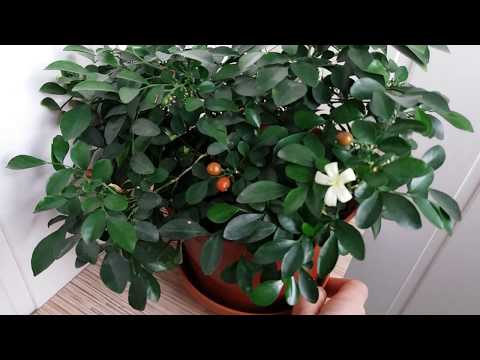

Watch this video on YouTube
Muraya properties: harm and benefit
The healing properties of muraya
Already in Ancient Egypt they knew that muraya had medicinal properties. There are many myths about this plant, and the history of its origin is shrouded in mystery. But what is the use of this plant, called the "tree of Japanese emperors"? The foliage contains hesperidin - this bitter glycoside affects the permeability of the capillaries. This plant also has an anti-inflammatory, fixing and wound healing effect, therefore it is used in alternative medicine for gastritis, diarrhea, dysentery and other diseases of the gastrointestinal tract, as well as for various wounds. Foliage is also used externally for painful sensations and aching joints. And the juice obtained from the foliage effectively eliminates headaches and toothaches.The berries of this culture contain biologically active substances, namely: antioxidants and vitamins. If you eat 3 or 4 such fruits per day, then this will be an excellent prevention of premature old age. They are also used for ischemic heart disease, hypertension and other diseases of the cardiovascular system. And they are also indicated for diabetes mellitus, because thanks to them, the blood sugar content decreases without the use of drugs.
It is very simple to make muraya tincture, for this you need to take berries and foliage in the same weight proportion. To begin with, the seeds are removed from the berries, then they and the foliage are crushed. The resulting mass is poured into a glass vessel, into which vodka is poured, while 2-3 tbsp. l. the mixture is taken 0.25 liters of vodka. A tightly sealed vessel is removed in a cool and dark place for 15 days, while the liquid must be systematically shaken. The finished tincture is taken in 20-30 drops twice or three times a day for 30 minutes. before the meal. It helps with heart failure, coronary heart disease, frequent migraines and as a preventive measure against myocardial infarction.
Contraindications
No undesirable side effects were reported with berries, foliage and muraya remedies. However, the alcoholic tincture of Muraya helps to lower blood pressure, therefore it is recommended to use it with caution in hypotensive patients. Still, experts do not advise to abuse the berries of this plant.


Watch this video on YouTube

